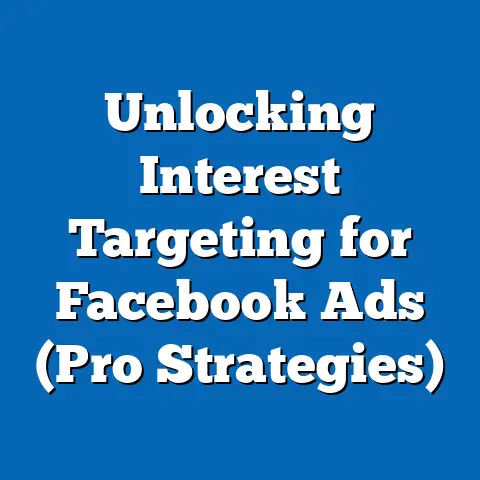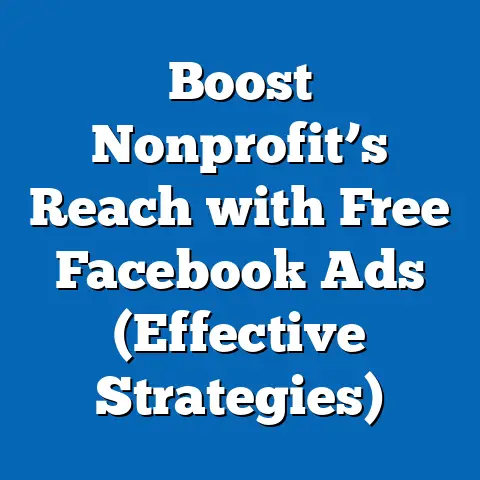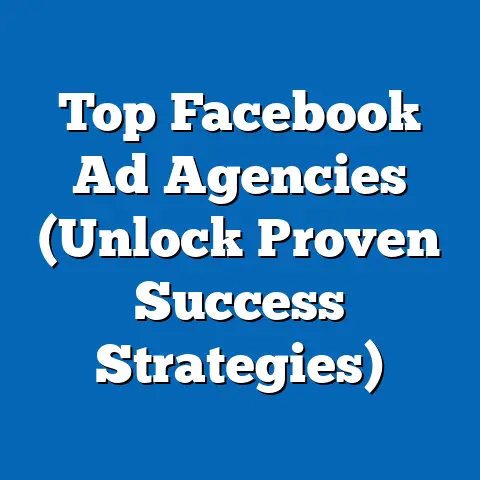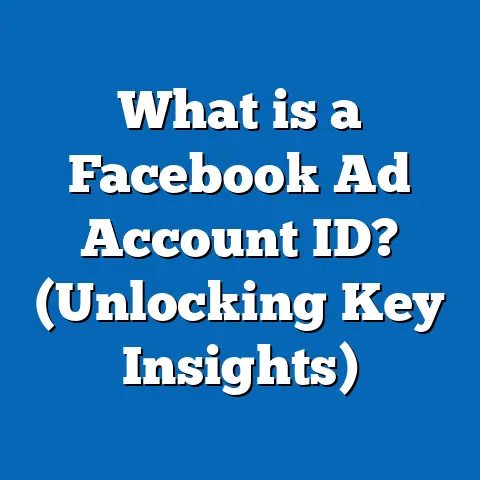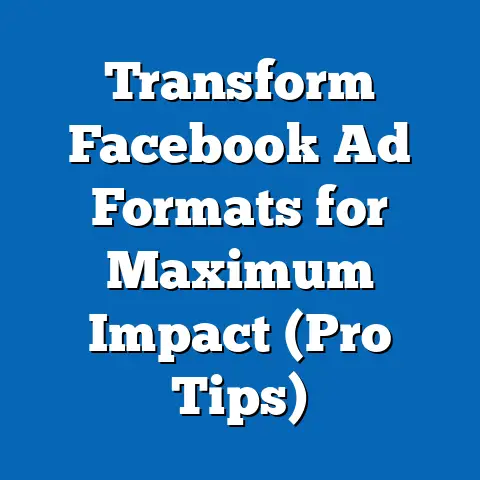Unlock Facebook Ads Success with Discount Codes (Game-Changer)
I’ll never forget the day I stumbled upon the true potential of discount codes in Facebook advertising. I was working with a small, family-owned bakery struggling to gain traction online. Their cakes were divine, their customer service impeccable, but their Facebook ads were falling flat. I remember the owner, a sweet woman named Sarah, looking disheartened as she showed me the dismal engagement rates. “I just don’t know what we’re doing wrong,” she sighed.
That’s when it hit me. We needed a hook, something irresistible to draw people in. We decided to try offering a 15% discount on their signature cupcakes through a Facebook ad campaign targeted at local residents interested in desserts. The results? Absolutely astounding. Within a week, Sarah’s bakery saw a 300% increase in online orders. The phone wouldn’t stop ringing, and the aroma of freshly baked goods filled the air with a renewed sense of purpose.
This wasn’t just about a discount; it was about creating a connection, sparking curiosity, and giving people a compelling reason to try something new. This experience cemented my belief that discount codes, when strategically implemented, are a game-changer in the world of Facebook advertising. They can transform struggling campaigns into roaring successes, attract new customers, and cultivate lasting loyalty. So, let’s dive into how you can unlock this same potential for your business!
Understanding Facebook Ads
Before we can harness the power of discount codes, it’s essential to have a solid grasp of Facebook advertising fundamentals. Think of Facebook Ads as a digital billboard, but one that’s infinitely more precise and targeted than anything you’d find on the side of a highway.
Overview of Facebook Ads
Facebook Ads are paid advertisements displayed on the Facebook platform, including Instagram, Messenger, and the Audience Network. They allow businesses to reach a massive and diverse audience, targeting specific demographics, interests, behaviors, and locations. The sheer scale of Facebook, with over 3 billion monthly active users, makes it a prime advertising platform for businesses of all sizes.
I see Facebook Ads as a vital tool in any modern marketing strategy. They provide unparalleled reach and targeting capabilities, enabling businesses to connect with potential customers who are genuinely interested in their products or services. Unlike traditional advertising methods, Facebook Ads are highly measurable, allowing you to track your ROI and optimize your campaigns for maximum effectiveness.
Target Audience
One of the most powerful features of Facebook Ads is its ability to target specific audiences. Imagine being able to show your ad only to people who are interested in baking, live within a 5-mile radius of your bakery, and are between the ages of 25 and 45. That’s the kind of precision Facebook offers.
To effectively target your audience, you need to understand your ideal customer. Who are they? What are their interests? What are their pain points? Facebook provides various targeting options based on:
- Demographics: Age, gender, location, education, job title, etc.
- Interests: Hobbies, passions, pages they like, etc.
- Behaviors: Purchase history, device usage, travel habits, etc.
- Custom Audiences: Upload your own customer list or create audiences based on website visitors or app users.
- Lookalike Audiences: Expand your reach by targeting people who are similar to your existing customers.
I once worked with a client who sold high-end fitness equipment. Initially, they were targeting a broad audience with generic ads. After refining their targeting to focus on individuals interested in specific fitness activities like CrossFit and marathon running, their conversion rates skyrocketed. This underscores the importance of laser-focused targeting.
Types of Facebook Ads
Facebook offers a variety of ad formats, each with its unique strengths and use cases. Understanding these formats is crucial for creating engaging and effective campaigns:
- Image Ads: Simple and visually appealing, ideal for showcasing a single product or service.
- Video Ads: Highly engaging, perfect for storytelling and demonstrating product features. I’ve found that short, attention-grabbing videos perform exceptionally well.
- Carousel Ads: Allow you to display multiple images or videos in a single ad unit, great for showcasing a range of products or features.
- Collection Ads: Designed for e-commerce businesses, allowing users to browse and purchase products directly from the ad.
- Instant Experience Ads: Full-screen, mobile-optimized ads that provide an immersive experience, perfect for brand storytelling and product demonstrations.
- Lead Ads: Collect leads directly from Facebook, making it easy for potential customers to express interest in your products or services.
- Slideshow Ads: Create a video-like experience using a series of still images, a cost-effective alternative to video ads.
Each ad format has its own set of specifications and best practices. Experimenting with different formats and analyzing their performance is key to finding what works best for your business.
Key Takeaway: Facebook Ads offer unparalleled reach and targeting capabilities. Understanding your audience and choosing the right ad format are essential for success.
The Power of Discount Codes
Discount codes are much more than just a way to offer a lower price. They’re powerful psychological tools that can drive consumer behavior and boost sales. Think of them as a little nudge, a compelling reason for someone to finally click that “Buy Now” button.
What Are Discount Codes?
Discount codes are alphanumeric codes that customers can enter during the checkout process to receive a discount on their purchase. They can offer a percentage off, a fixed dollar amount off, free shipping, or other special offers. Discount codes are a versatile marketing tool that can be used to achieve a variety of goals, from acquiring new customers to increasing order value.
I’ve seen businesses use discount codes in countless creative ways. Some offer exclusive discounts to email subscribers, while others use them to reward loyal customers. The possibilities are endless.
Psychological Impact
Discount codes tap into several powerful psychological triggers:
- Urgency: Limited-time offers create a sense of urgency, encouraging customers to make a purchase before the discount expires. Phrases like “Limited Time Only” or “Offer Ends Soon” can be incredibly effective.
- Scarcity: Exclusive discounts or limited quantities create a sense of scarcity, making the offer more appealing. Think “Only 10 Left!” or “Exclusive Offer for First 100 Customers.”
- Loss Aversion: People are more motivated to avoid losing something than to gain something of equal value. Discount codes can trigger loss aversion by making customers feel like they’re missing out on a great deal if they don’t take advantage of the offer.
- Value Perception: Discount codes increase the perceived value of a product or service. Customers feel like they’re getting a better deal, even if the actual discount is relatively small.
- Reciprocity: Offering a discount can create a sense of reciprocity, making customers feel obligated to make a purchase. This is especially true if the discount is presented as a thank you for their loyalty or support.
I remember a campaign I ran for a clothing retailer that offered a “mystery discount” to new email subscribers. Customers received a code that revealed a random discount amount, ranging from 10% to 30%. This campaign was a huge success, generating a massive influx of new subscribers and driving a significant increase in sales. The element of surprise and the potential for a large discount proved irresistible.
Case Studies
Let’s look at some real-world examples of brands that have successfully used discount codes in their Facebook ad campaigns:
- ASOS: The online fashion retailer frequently uses discount codes in its Facebook ads to drive sales. They often offer percentage-off discounts, free shipping, or exclusive offers for students. Their ads are visually appealing and clearly communicate the value proposition, resulting in high click-through rates and conversions.
- HelloFresh: The meal kit delivery service uses discount codes to attract new customers. They offer significant discounts on the first few boxes, making it easy for people to try their service without breaking the bank. Their ads are targeted at busy professionals and families who are looking for convenient and healthy meal options.
- Warby Parker: The eyewear company uses discount codes to incentivize referrals. They offer a discount to both the referrer and the referred friend, creating a win-win situation. Their ads are targeted at existing customers who are likely to recommend their products to others.
These examples demonstrate the versatility of discount codes and their ability to drive results across different industries.
Key Takeaway: Discount codes are powerful psychological tools that can drive consumer behavior and boost sales. Understanding the psychological triggers they activate is crucial for creating effective campaigns.
Integrating Discount Codes into Facebook Ads
Now that we understand the power of discount codes, let’s explore how to effectively integrate them into your Facebook ad campaigns. The key is to strategically place your discount code within your ads, crafting compelling copy and visuals that highlight the value proposition.
Strategic Placement
Where you place your discount code within your ad can significantly impact its effectiveness. Here are some best practices:
- Ad Copy: Clearly mention the discount code in your ad copy, highlighting the specific offer and any terms and conditions. Make it easy for customers to understand the value they’re receiving. For example, “Get 20% off your first order with code WELCOME20.”
- Image or Video: Visually display the discount code in your ad image or video. This can be especially effective for capturing attention and making the offer memorable.
- Call-to-Action (CTA) Button: Use a clear and compelling CTA button that encourages customers to take action. Examples include “Shop Now,” “Get Discount,” or “Redeem Offer.”
- Landing Page: Ensure the discount code is prominently displayed on your landing page, making it easy for customers to redeem the offer.
I’ve found that using a combination of these placements is the most effective approach. Mention the discount code in your ad copy, visually display it in your ad image, and use a clear CTA button that directs customers to a landing page where they can easily redeem the offer.
Creating Engaging Ads
Crafting compelling ad copy and visuals is essential for highlighting your discount codes and driving engagement. Here are some tips:
- Highlight the Value: Clearly communicate the value of the discount code. What specific benefit will customers receive? Focus on the savings, the convenience, or the exclusivity of the offer.
- Use Strong Visuals: Use high-quality images or videos that capture attention and showcase your products or services. Make sure your visuals are relevant to your target audience and the offer you’re promoting.
- Create a Sense of Urgency: Use language that creates a sense of urgency, encouraging customers to take action before the offer expires. Examples include “Limited Time Only,” “Offer Ends Soon,” or “While Supplies Last.”
- Target the Right Audience: Ensure your ads are targeted at the right audience. Use Facebook’s targeting options to reach people who are genuinely interested in your products or services and are likely to redeem the discount code.
- Keep it Simple: Make it easy for customers to understand the offer and redeem the discount code. Avoid complicated terms and conditions or confusing redemption processes.
I once worked with a furniture store that was struggling to drive online sales. We created a Facebook ad campaign that offered a 10% discount on all sofas, using a high-quality image of a stylish sofa and compelling ad copy that highlighted the comfort and affordability of their products. The ad also included a clear CTA button that directed customers to the sofa section of their website. This campaign resulted in a significant increase in online sales and helped the furniture store reach a wider audience.
Ad Objectives
Aligning your discount codes with specific ad objectives is crucial for maximizing effectiveness. Facebook offers a variety of ad objectives, each designed to achieve a different goal:
- Brand Awareness: Reach a broad audience and increase awareness of your brand. Discount codes can be used to incentivize engagement and encourage people to learn more about your business.
- Reach: Show your ad to the maximum number of people within your target audience. Discount codes can be used to increase the appeal of your ad and encourage people to take notice.
- Traffic: Drive traffic to your website or landing page. Discount codes can be used to incentivize clicks and encourage people to explore your products or services.
- Engagement: Increase engagement with your Facebook page or posts. Discount codes can be used to encourage likes, comments, shares, and follows.
- Lead Generation: Collect leads from potential customers. Discount codes can be used to incentivize people to provide their contact information.
- Conversions: Drive sales or other desired actions on your website or app. Discount codes can be used to incentivize purchases and increase conversion rates.
I recommend choosing an ad objective that aligns with your overall marketing goals and the specific purpose of your discount code campaign. For example, if your goal is to acquire new customers, you might choose the lead generation or conversions objective. If your goal is to increase brand awareness, you might choose the brand awareness or reach objective.
Key Takeaway: Strategically place your discount code within your ads, craft compelling copy and visuals, and align your discount codes with specific ad objectives to maximize effectiveness.
Crafting the Perfect Discount Code Campaign
Creating a successful discount code campaign requires careful planning, execution, and optimization. It’s not enough to simply offer a discount; you need to set clear goals, test different approaches, and track your results to ensure you’re getting the best possible return on your investment.
Campaign Goals
Before you launch your discount code campaign, it’s essential to define your goals. What specific outcomes do you want to achieve? Examples include:
- Increase Sales: Increase sales by X% within a specific timeframe.
- Grow Email List: Grow your email list by Y subscribers.
- Drive Website Traffic: Increase website traffic by Z%.
- Acquire New Customers: Acquire a specific number of new customers.
- Increase Average Order Value: Increase the average order value by a certain percentage.
Having clear goals will help you stay focused and measure the success of your campaign. I recommend setting SMART goals – Specific, Measurable, Achievable, Relevant, and Time-bound.
For example, instead of setting a vague goal like “increase sales,” set a SMART goal like “increase online sales by 15% within the next 30 days.” This will give you a clear target to aim for and make it easier to track your progress.
Testing & Optimization
A/B testing is a crucial part of any successful discount code campaign. It involves testing different versions of your ads, discount codes, and landing pages to see which performs best.
Here are some elements you can A/B test:
- Discount Amount: Test different discount amounts (e.g., 10% off, 20% off, $10 off) to see which generates the highest conversion rate.
- Discount Type: Test different types of discounts (e.g., percentage off, fixed dollar amount off, free shipping) to see which is most appealing to your target audience.
- Ad Copy: Test different ad copy variations to see which generates the highest click-through rate and conversion rate.
- Ad Visuals: Test different ad images or videos to see which captures the most attention and drives the most engagement.
- Call-to-Action Button: Test different CTA buttons to see which generates the most clicks and conversions.
- Landing Page: Test different landing page designs and layouts to see which converts the best.
I’ve found that even small changes can have a significant impact on campaign performance. For example, simply changing the wording of your CTA button from “Shop Now” to “Get Discount” can increase your click-through rate by several percentage points.
Facebook’s ad platform makes A/B testing easy. You can create multiple versions of your ads and let Facebook automatically distribute traffic to the best-performing version.
Tracking Success
Tracking the performance of your discount code campaign is essential for measuring its success and identifying areas for improvement. Facebook Insights provides a wealth of data that you can use to track your key metrics, including:
- Reach: The number of people who saw your ad.
- Impressions: The number of times your ad was displayed.
- Click-Through Rate (CTR): The percentage of people who clicked on your ad.
- Conversion Rate: The percentage of people who completed a desired action (e.g., making a purchase, signing up for an email list).
- Cost Per Conversion: The cost of acquiring a single conversion.
- Return on Ad Spend (ROAS): The revenue generated for every dollar spent on advertising.
In addition to Facebook Insights, you can also use other analytics tools like Google Analytics to track the performance of your discount code campaign. By analyzing your data, you can identify which ads, discount codes, and landing pages are performing well and which are not. This will allow you to make data-driven decisions and optimize your campaign for maximum effectiveness.
Key Takeaway: Set clear goals, test different approaches, and track your results to ensure you’re getting the best possible return on your investment.
Common Mistakes and How to Avoid Them
Even with the best planning and execution, discount code campaigns can sometimes fall short. It’s important to be aware of common mistakes and take steps to avoid them.
Overly Complicated Codes
One of the biggest mistakes I see businesses make is using overly complicated discount codes. Long, complex codes are difficult to remember and prone to errors. This can lead to frustration and abandoned purchases.
Keep your discount codes simple and easy to remember. Use short, memorable words or phrases that are relevant to your brand or offer. For example, “WELCOME10” or “SUMMER20.”
Avoid using special characters or numbers that are difficult to distinguish. Also, make sure your discount codes are easy to type on mobile devices.
Neglecting Target Audience
Another common mistake is neglecting to consider your target audience when creating discount codes and ads. A discount code that appeals to one audience may not appeal to another.
For example, a discount code that offers free shipping may be highly appealing to customers who are purchasing expensive items, but it may not be as appealing to customers who are purchasing inexpensive items.
Tailor your discount codes and ads to your target audience. Consider their needs, interests, and preferences. Use language and visuals that resonate with them.
Ignoring Analytics
Ignoring analytics is a recipe for disaster. Without tracking and analyzing your campaign performance, you’re flying blind. You won’t know which ads, discount codes, and landing pages are performing well and which are not. This will make it impossible to optimize your campaign for maximum effectiveness.
Regularly monitor your key metrics, such as reach, impressions, click-through rate, conversion rate, cost per conversion, and return on ad spend. Use this data to make informed decisions about your campaign.
If you see that a particular ad or discount code is not performing well, don’t be afraid to make changes. Experiment with different approaches and track your results to see what works best.
Key Takeaway: Avoid overly complicated codes, tailor your discount codes and ads to your target audience, and regularly monitor your key metrics to make data-driven decisions.
Conclusion
Integrating discount codes into your Facebook ad strategy is a game-changer. It’s a powerful way to attract new customers, boost sales, and build brand loyalty. From understanding the psychology behind discounts to strategically placing them in your ads, we’ve covered the essential elements for crafting successful campaigns.
Remember Sarah, the bakery owner? After implementing discount codes, her business transformed. She not only saw an immediate increase in sales but also cultivated a loyal customer base that continues to support her bakery today.
Now, it’s your turn. Take the leap and experiment with discount codes in your own Facebook ad campaigns. Start small, test different approaches, and track your results. The potential for growth and success is within your reach. Don’t just take my word for it; experience the transformative power of discount codes for yourself. Create your first campaign today and watch your business flourish!

